NOTE: With all of the answers below, If you have an alternate opinion about any one, please share! We are all here to learn from each other. Even the most experienced trackers continue to expand their knowledge through their own and others’ experiences, so don’t hesitate to share additional information, observations, questions, or experience.
In the spirit of community learning, we use first names of participant’s responses in these quizzes to draw out elements of observations. If you’d rather that we don’t use your name, just ask us!
There are 10 questions in this quiz, some are from the northeastern and midwestern USA, and some are from South Africa. More exact locations are given with the individual questions.
Question 1.
This photo comes from Shane Hawkins in Pennsylvania, near the border of southwestern NY, USA, North America.
Who or what is it? Describe what you see.
Scroll down for the answer.
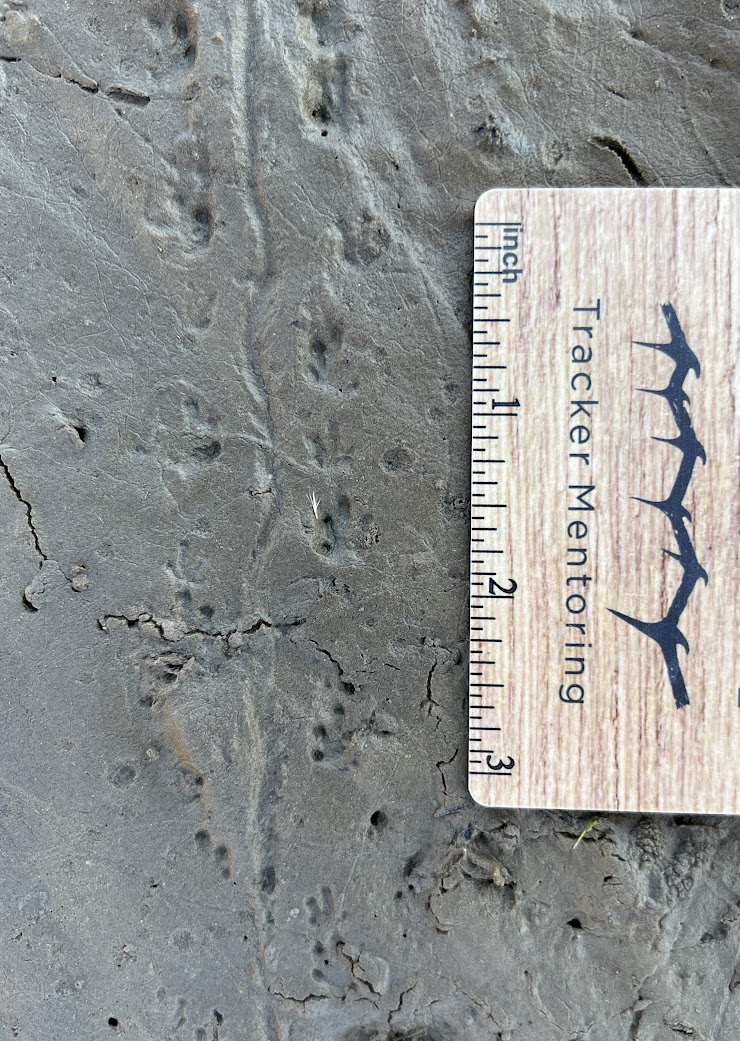
ANSWER: Salamander tracks
These beings don’t live everywhere in the world, with most requiring a dark, moist and humid environment. But, their relatives are widespread, and fortunately (or unfortunately – maybe this is a topic for research!) we aren’t expected to tell one species from another unless it’s very obvious (as in, it’s the only species around, or of a very distinct size or morphology.)
Jiska said, “Some kind of frog? I think I see a frog prints and a bit of a hop, but I’m very confused by the what seems a drag of a body in the middle!!!! AARGH!”
I love the passion she exhibits. It makes me feel like I do when I’m being evaluated.
Ana Maria added, “I see a variety of small tracks with a long line in the middle. The tracks appear to be four toed, with blunt nail impressions on many of them. There are a lot of footprints close together, which suggests a walking animal with short legs. For this reason, I would initially suspect these tracks were created by a reptile and amphibian. The depth of the holes in each track initially made me suspect turtle, but after further inspection I believe this trail was made by a salamander because of the long narrow toes!”
And Maria gave us more info, “This photo shows a small trail moving towards the top of the page. There is a tail drag down the middle of the trail, and feet with a short stride moving in an understep walk. I think I’m seeing four toes on the hind foot and three on the front. These are the tracks of a small salamander or possibly a newt (if I’m counting the toes wrong.) This might be a four toed salamander (assuming that the fronts have four toes that aren’t registering completely). But honestly I don’t know how to differentiate different salamanders of similar sizes!”
Shane thought that these tracks, this trail, was/were made by an Eastern Newt, which is the most common, small species in the eastern deciduous forests.
Question 2.
This photo comes from Shane Hawkins in Southwestern New York, USA, North America.
Who or what is it? Describe what you see.
Scroll down for the answer.
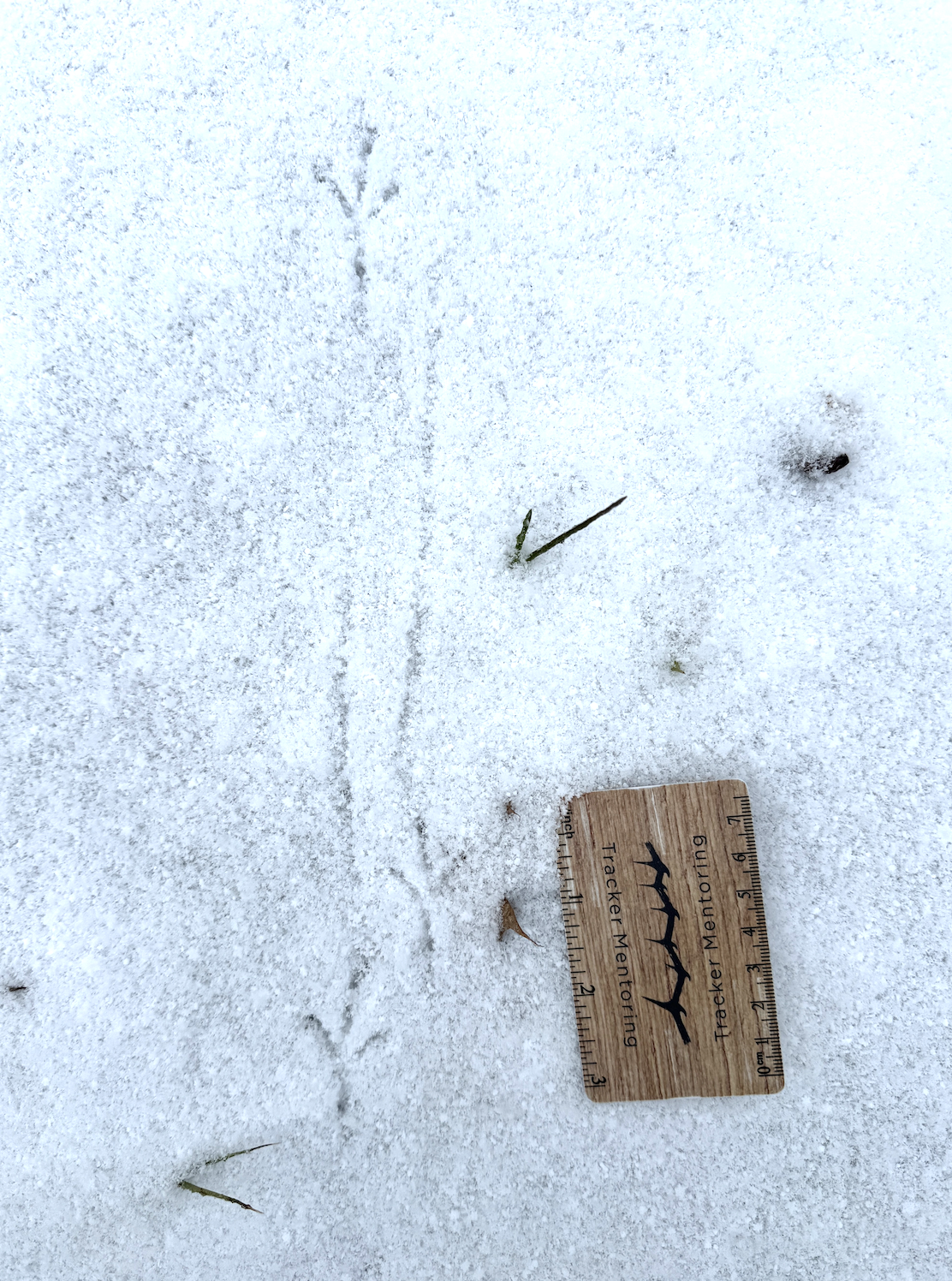
ANSWER: American robin tracks
When it comes to distinguishing bird tracks, the intimidation factor is high, so where do we start? With foot structure. Does it have a hind toe? What configuration are the toes in (3 forward and 0-1 hind, 2 forward and 2 back), is it partially webbed, fully webbed? Then, how is it moving, what habitat are we in, what are the most common species here, and how big is it? Then, we might get into morphology.
Michael started us off nicely with, “Bird with anisodactyl foot shape. It seems to be hoping or skipping along with a long stride so it’s not going to be a dove or pigeon or other very short legged bird that generally walks with short steps.”
Sören and Cal followed the same line of reasoning, respectively, with “A hopping pattern of a small songbird, some nail-drag,” and “Perching bird hopping in light snow.”
And Maria attempted the species, correctly, with, “This trail is made by an American robin. The skipping stride is often seen in robins. The feet have three toes pointing forward and one pointing backwards, with a well-developed hallux. They have a slight inward curve, with toes 2 and 4 curving outward, like a peeled banana.”
Question 3.
This photo comes from Shane Hawkins in Southwestern New York, USA, North America.
Who or what is it? Describe what you see.
Scroll down for the answer.
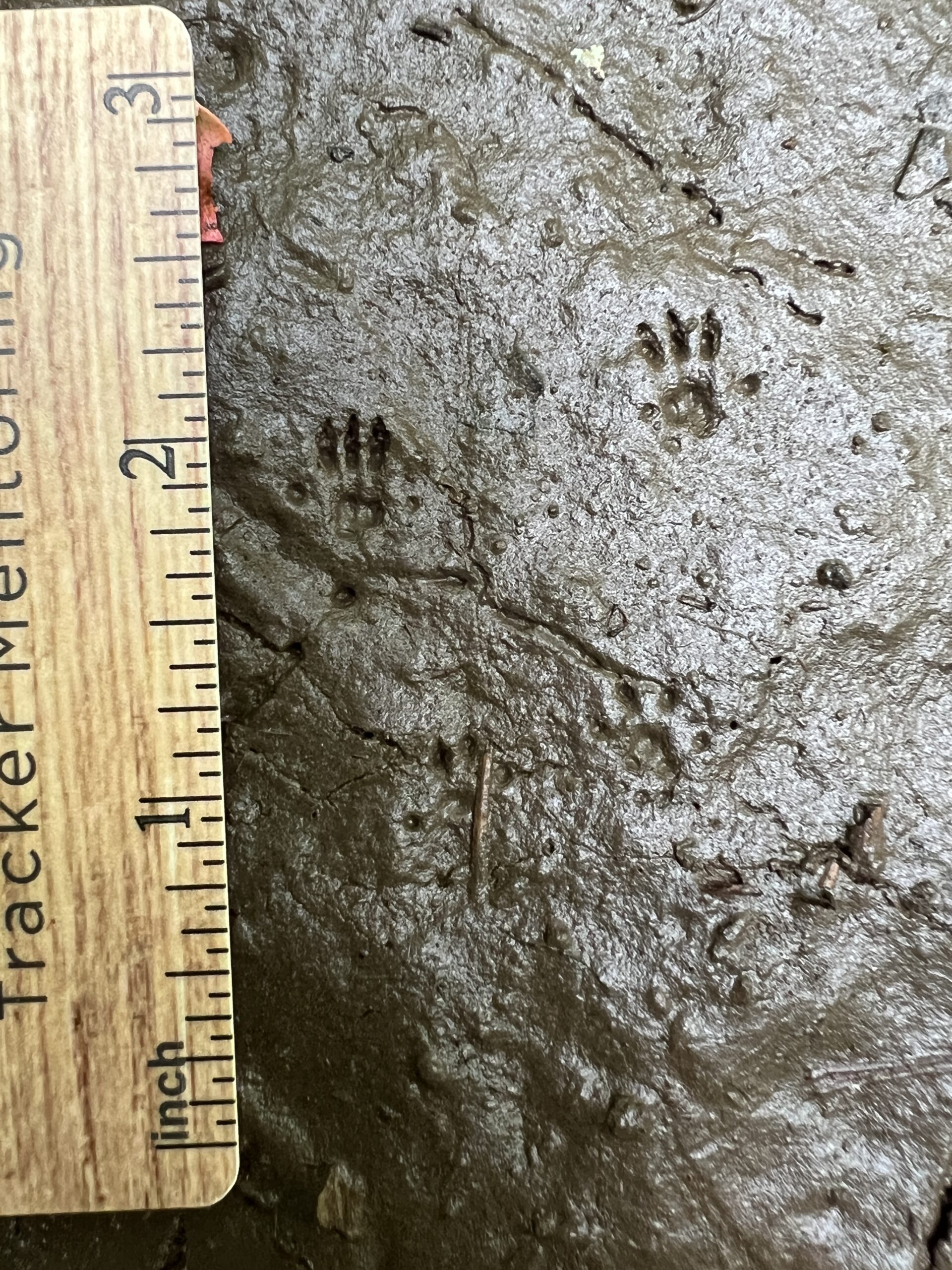
ANSWER: Peromyscus tracks (white-footed or deer mouse)
Michael and Tracy, respectively pointed out the general features to begin teasing apart this id, “Mouse sized rodent bounding tracks – four toes on front feet, five toes on hind feet (middle 3 grouped pointing forwards and 2 outside toes pointing to each side),” and, “Rodentia with 5 toes on hind and the 1-3-1 pattern. 4 digits on front. Bounding gait. Very tiny. Bulbous front toes? Deer mouse?”
And Logan confirmed, “I see a small rodent bound pattern. Hind feet have the 1-3-1 toe arrangement. Whole group width seems to be a little over an inch, which is pretty small! (to me this rules out things like rats and chipmunks). Also the toes on the front feet look nice and rounded, with not a lot of negative space between the toes and pads. Reminds me of some woodrat tracks I’ve seen out west. Anyways, would call this a Peromyscus mouse sp.”
Maria added some info to help differentiate these from vole tracks, “These are rodent tracks, as is evident by the bounding pattern and the four toes on the front feet and five toes on the hind, with the three middle toes more or less in a line. The size puts us in range for mouse or vole, but vole tracks typically have more of a fingery look and are more widely splayed. I believe this is a deer mouse due to the bulbous toe and palm pads.”
Question 4.
This photo comes from Shane Hawkins in Benzette, Pennsylvania, USA, North America.
Who or what is it? Describe what you see.
Scroll down for the answer.
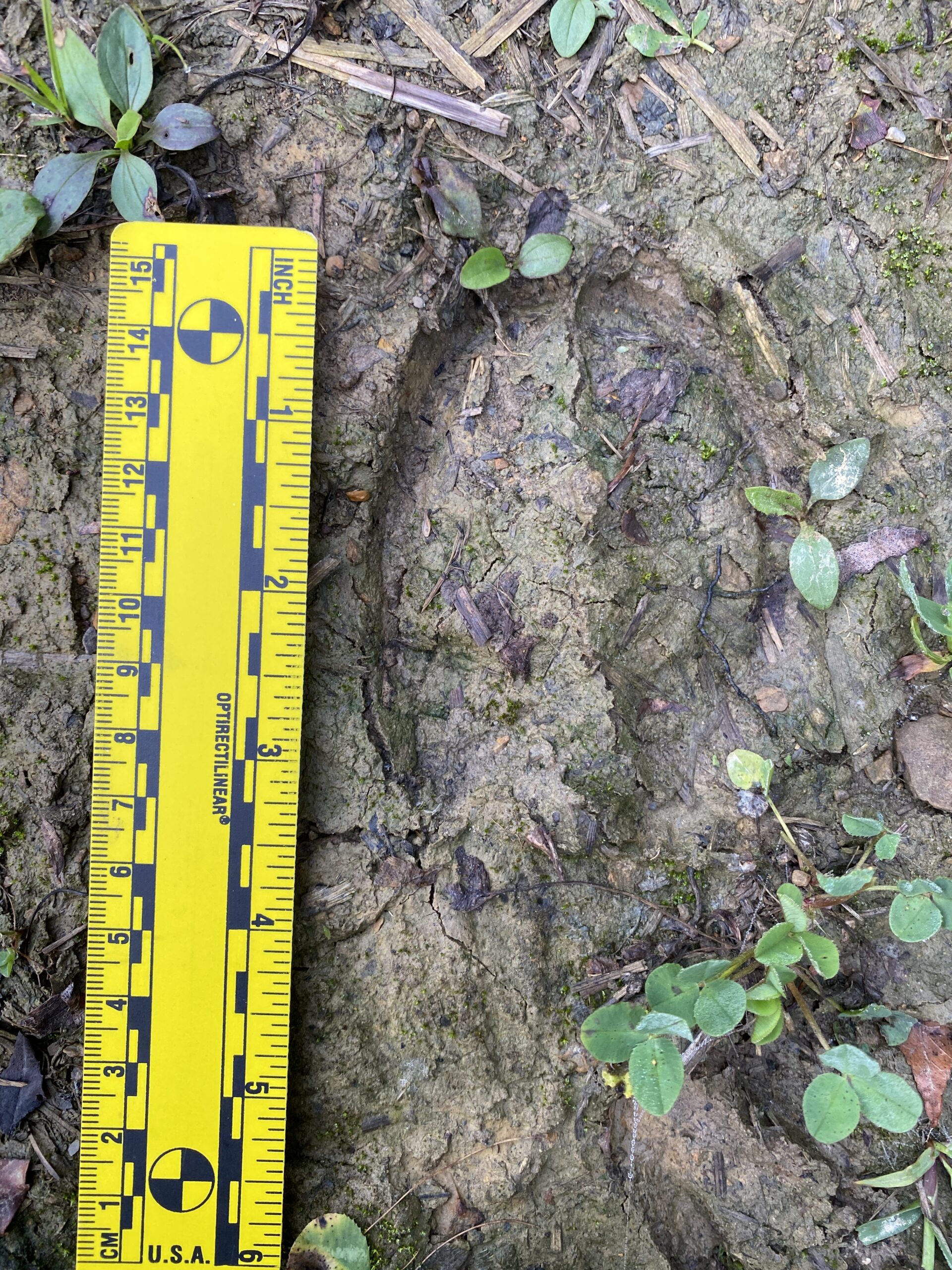
ANSWER: Roosevelt elk tracks
Sören hypothesized, “A bigger double hoofed animal, not boar/pig because the negative space runs all the way between the toes, some deer, I was thinking elk maybe because it looks like our European red deer but it looks small in size for elk…”
And Maria nailed it, with, “I see a rounded outline with two parallel lines down the middle. These are the cleaves of a hoofed animal. The track size is about 3.25 inches long. Due to the location, I am considering elk or white tailed deer. White tailed deer cleaves are more pointed at the tips, like an inverted heart shape. Even though these tracks are on the small side, I would call them elk because they look too blocky to be deer.”
Question 5.
This photo comes from Shane Hawkins in southern Vermont, USA, North America.
What happened here? Who is responsible?
Scroll down for the answer.
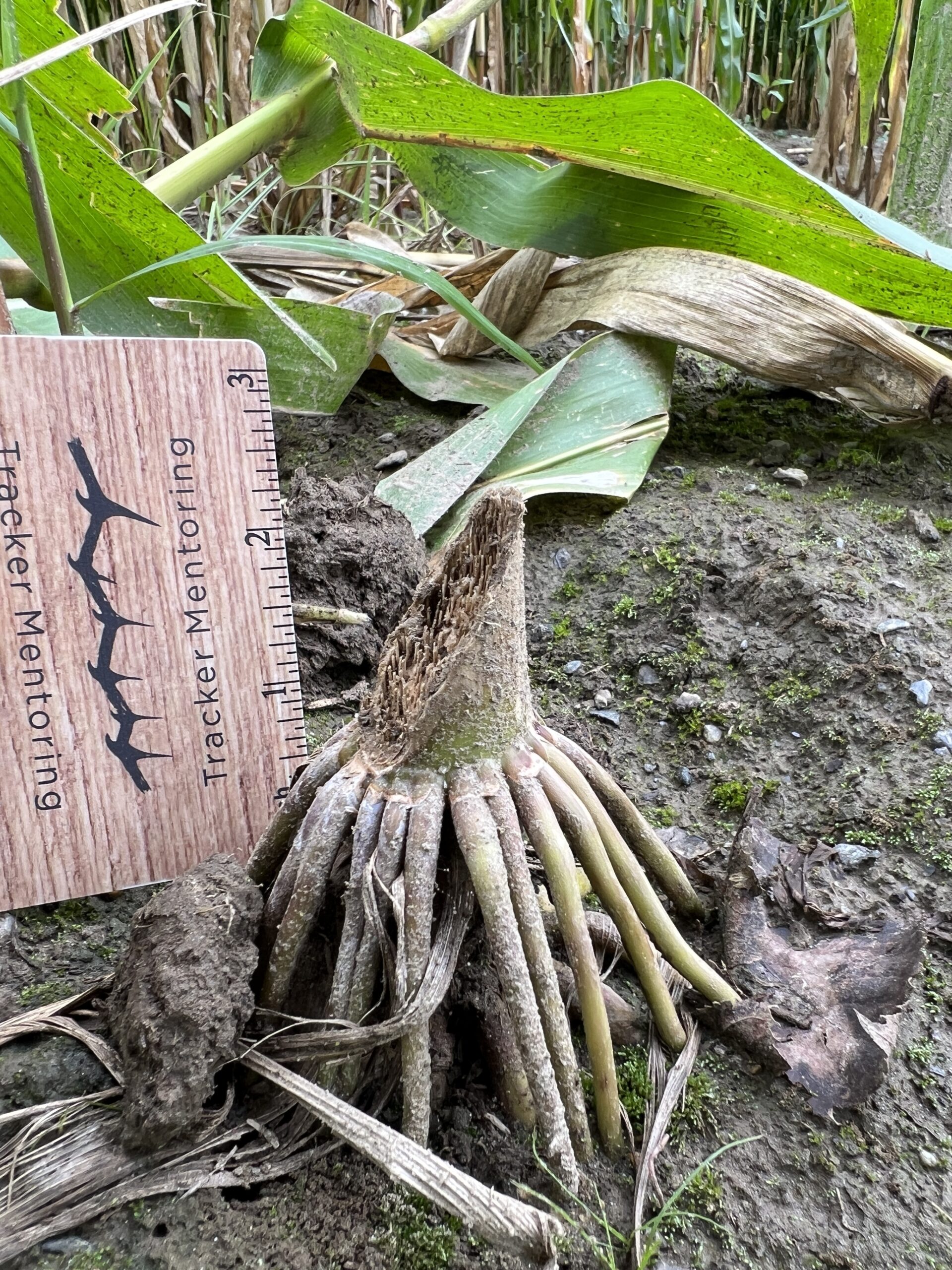
ANSWER: Beaver harvesting corn stalks
Jiska got close to the answer, with, “holy moly – I don’t know. an animal gnawed through the stem of what looks like corn? maybe a Nutria (? 🙂 Learnt a new word in Kenya) trying to get access to the corn itself?” Jiska refers to our recent Black Leopard Tracking program in Kenya, where we saw South American nutria swimming in the river systems! We were all a bit confounded at the sight, with Lee saying it might be an otter, Bill saying it was a beaver, and me (Kersey) saying it might be a muskrat, because it didn’t fit any of our search images for the area. Dan, our local guide, then pointed to a photo in his phone app with the image of an introduced, non-native nutria in the ecosystem!
Ana Maria worked it out, “Something appears to have removed most of a corn stalk. This is clearly not a new bite mark. It does not point to being a human cut with the ridged edges. The width of the stalk suggests beaver chewing to me.”
And Michael defaulted to the book, “Beaver feeding sign. Looks just like the pictures in Mark Elbroch’s mammal book.” BAM!
Question 6.
This photo comes from Sandy Reed in the Greater Kruger Area of South Africa, near the town of Hoedspruit.
Who left this track? Describe what you see.
Scroll down for the answer.
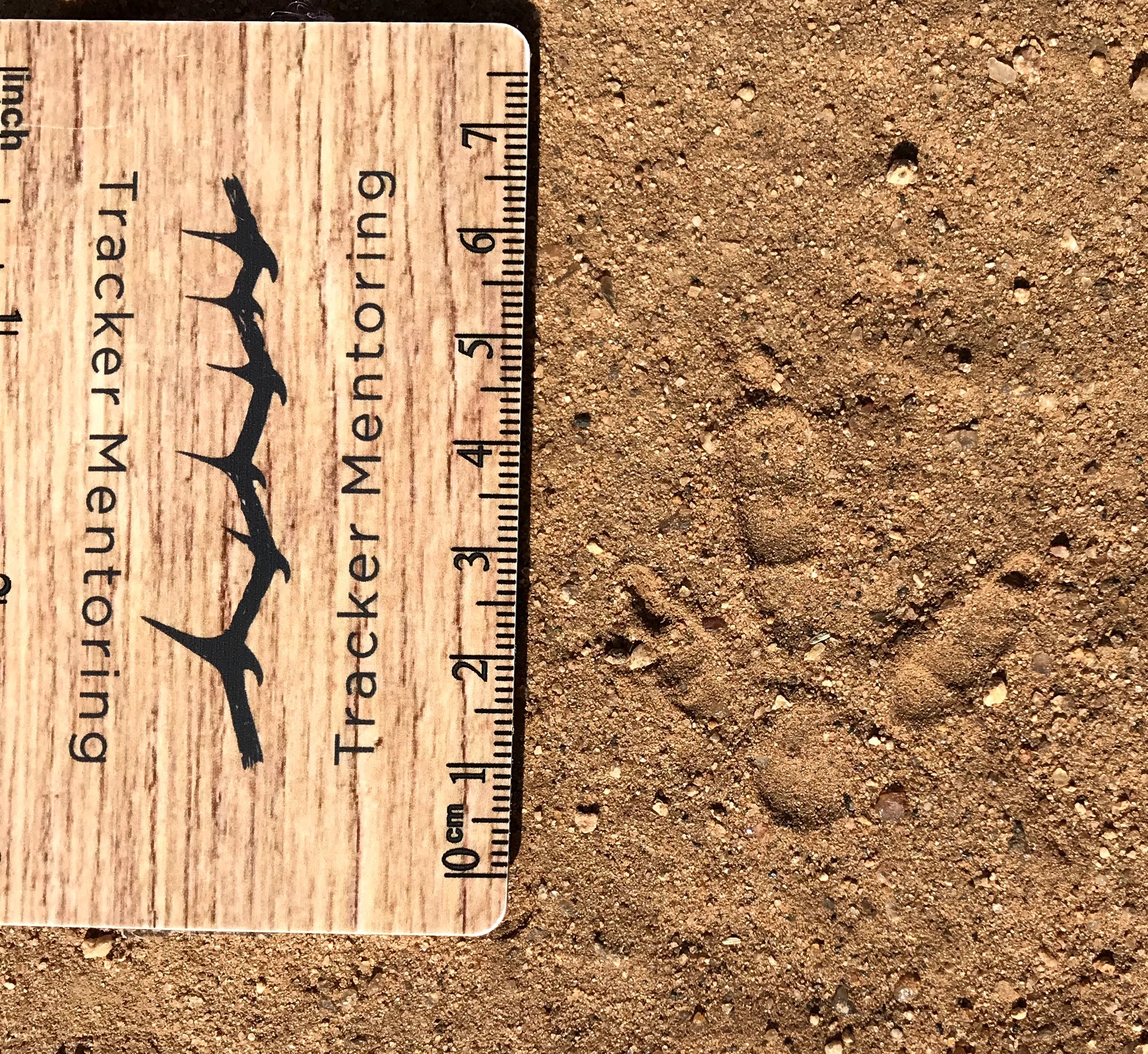
ANSWER: Red-crested korhaan track
I really liked Logan’s process, not knowing the birds of the area, “I see a 3 toed bird track, with no hallux (maybe the faintest of one). Big pad as well (is that considered a carpal pad?). So we’re looking at a bird that spends a lot of time on the ground, but also isn’t a large bird. Scanning eBird lists for the region for my guess, gonna go with Natal’s Spurfowl as a shot in the dark guess.” So, he didn’t get the species, but that’s the way to do it: look at the features and find out what birds are in the area.
Cal got the answer, with, “Perhaps a korhaan. Been a minute since I trained on these.” But, WHY, Cal? <<grin>>
Michael and Jiska, respectively, gave us more details, with, “Right foot of a korhaan or small bustard – thick toed tridactyl print with prominent claws and solid heel pad. Size suggests one of the black korhaans but I wouldn’t be surprised if it’s a small bustard track,” and “I think korhaan – i see a track of about a little over 4 cm, with a large metatarsal pad, no hallux, and a slightly offset toe…”
Question 7.
This photo was taken by Sandy Reed in Ontario, Canada.
What happened to this mushroom cap?
Scroll down for the answer.
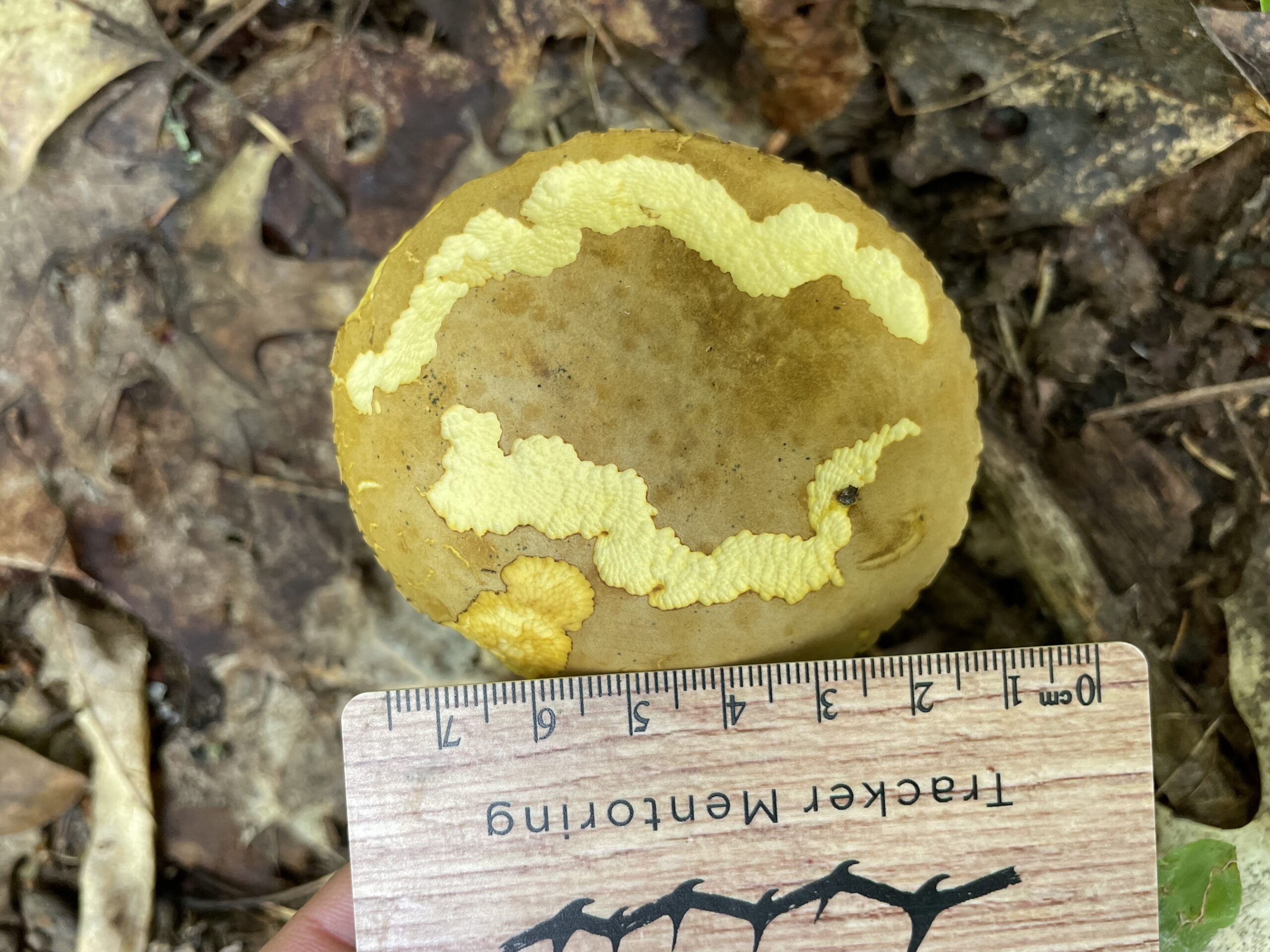
ANSWER: Slug feeding sign on a mushroom
Logan described this as, “Beautiful! This looks like snail feeding sign–you can see the arcs and scraping movement of the radula.”
And Sören added, “Beautifull snail/slug feesing sign with their specific pattern where they seem to scoop out pieces of mushroom with an ice-cream scoop.”
Question 8.
This photo was taken by Sandy Reed in the Greater Kruger Area of South Africa, near the town of Hoedspruit.
Who left this track? Describe what you see.
Scroll down for the answer.
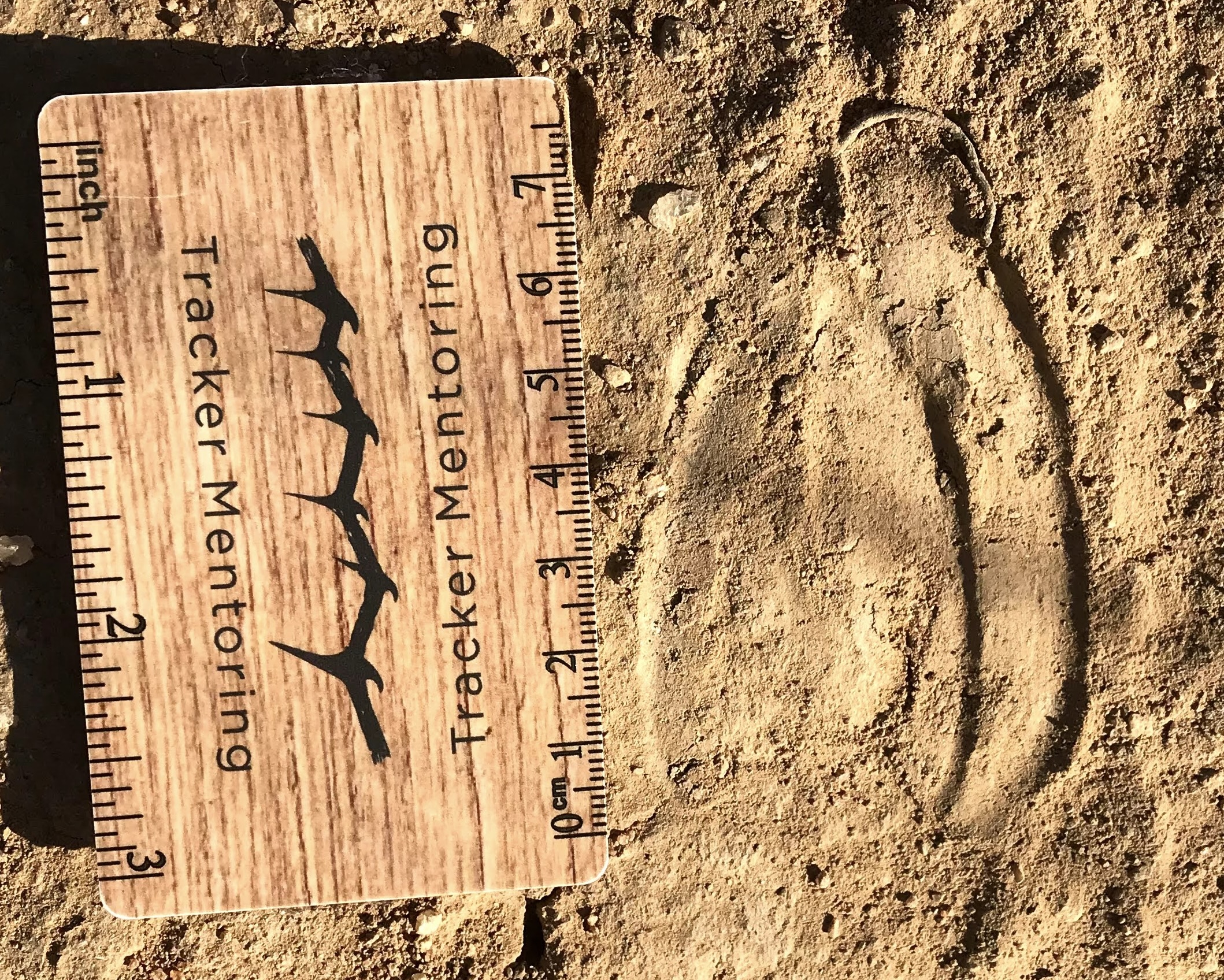
ANSWER: Kudu tracks
Everybody knew that this was a hoofed animal. Well done! That’s where we start.
Differentiating antelope in Africa is akin to differentiating small mammals in the northern hemisphere – there are lots of different species, many overlap in size, and the features and behaviours and distributions help us to sort them out. This is tough because we are only given 2 overlapping tracks and not a full stride, so getting an idea of the body size of this antelope is challenging.
Maria said, “I see a double-register of a hoofed animal. The hoof is narrow, and the length of the hind track is a little over 6cm. There are many deer-sized ungulates in South Africa and I don’t know how to tell their tracks apart. But maybe it’s a nyala?”
That’s a good guess, but these tracks are a little longer, proportionally, than they are wide (and that statement is a relative comparison that’s based on my years of looking at African antelope tracks, because, how do you know what “proportionately” means, unless you’ve seen it, too?) Size is not as helpful here when trying to differentiate between nyala and kudu, because this is in the overlap zone between a big male nyala and a small female or juvenile male kudu.
Michael (I think) took an informed guess from the literature, and got it, “Kudu – oval/shield shaped prints, slightly smaller hind print fairly neatly placed on top of front print, very little discernable space between each half of the hoof.”
Question 9.
This photo was taken by Sandy Reed in Ontario, Canada.
Who left this scat pile? Why?
Scroll down for the answer.
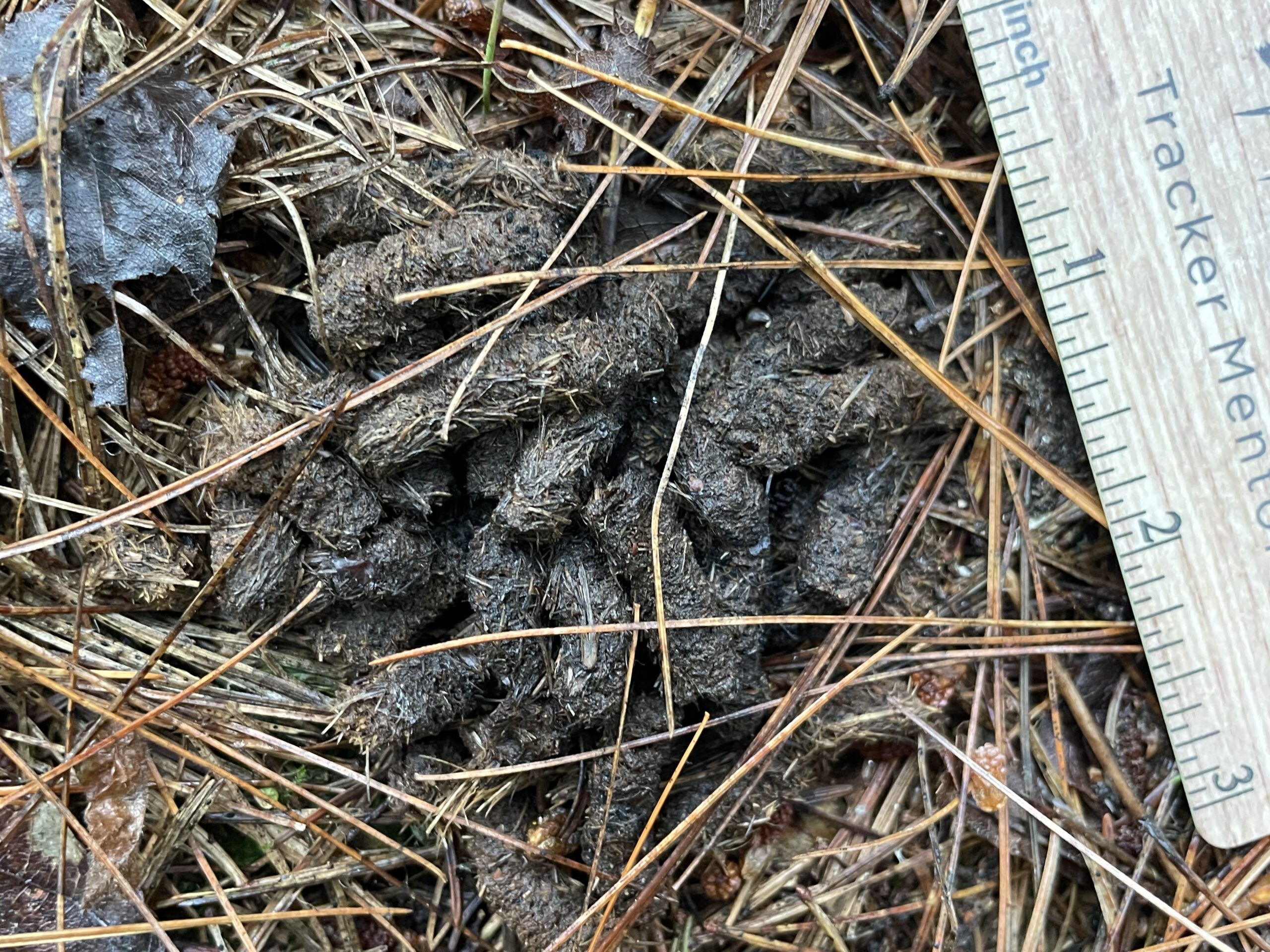
ANSWER: Grouse scat
Maria described it beautifully, “I see fibrous, tubular scats in some pine needles/vegetation. They’re around an inch to an inch and a quarter long, about a quarter inch in diameter. The uniform, tubular appearance, filled with grassy material has me thinking game bird, and the size, contents, and fact that it’s in a big pile points to grouse. I was also considering duck, but I’ve never seen their scat accumulate like this. Grouse, on the other hand, will leave fairly large piles at roosting sites.”
And Ana Maria added some aging and comparisons, “This little scat pile appears to be formed of primarily plant parts. The way it is left in a little pile, I believe this is the scat of a grouse that was made over the winter while the grouse was in the snow, and then has been revealed after the melt. I would normally expect to see white urea in the scat, but since it looks to be partially decomposed already, that may have already faded. I also considered porcupine, but it is smaller and longer than the average porcupine scat I have seen.”
Question 10.
This photo was taken by Sandy Reed in the Greater Kruger Area of South Africa, near the town of Hoedspruit.
Who left this scat pile? Why?
Scroll down for the answer.
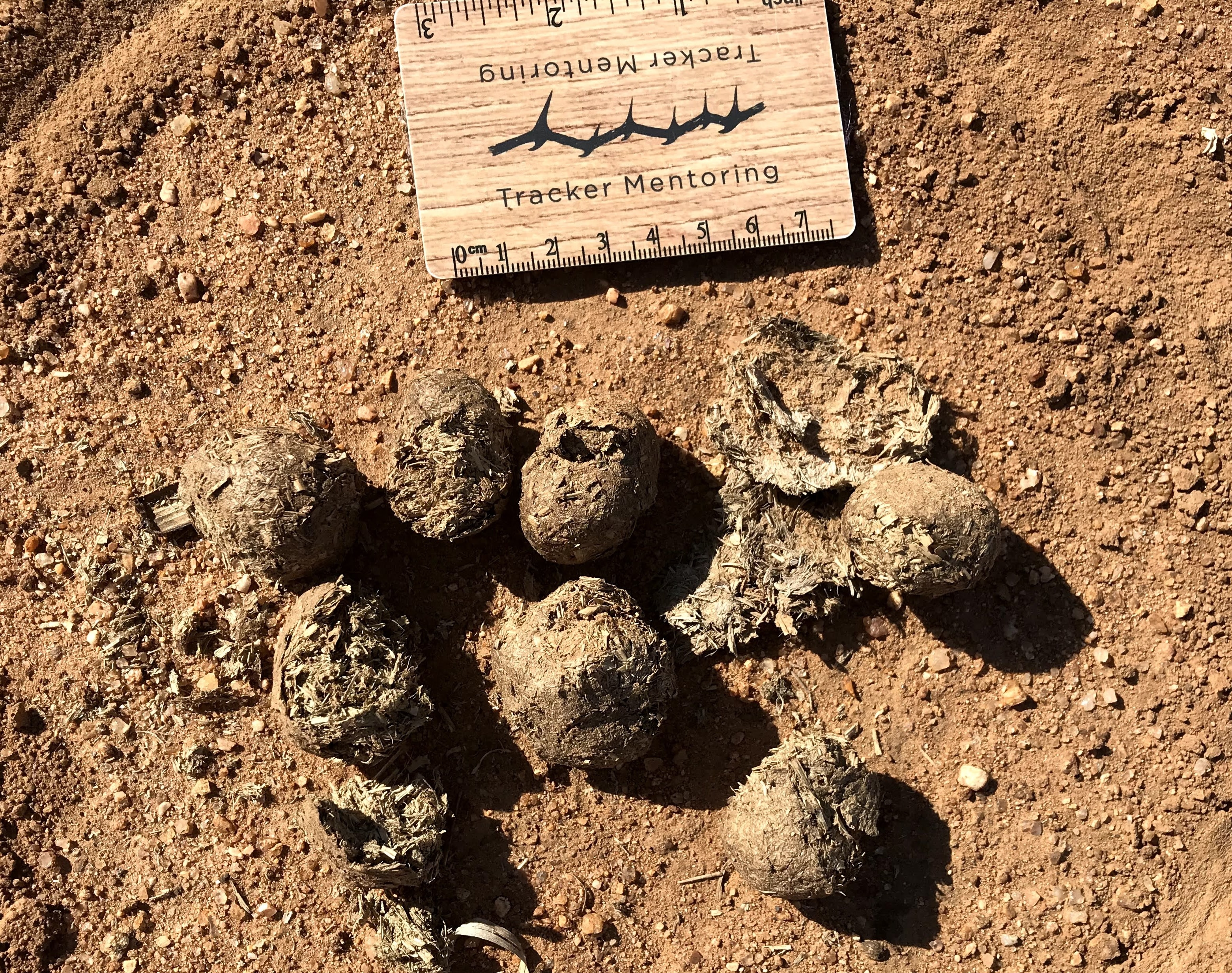
ANSWER: Warthog dung
Tracy said, “Excited to learn. Large pellet-large ungulate….?”
Indeed, and I love your curiosity, Tracy. That’s exactly what it takes to become a good tracker. Keep going.
So, what’s the first question we ask ourselves when we are trying to identify who left a scat behind?
What is it made of (what’s the animal eating)?
And many of you did ask yourself that exact question. Well done. It’s hard to see content in photos, but you all said vegetation. The fact that you can see vegetation tells us that this is not a ruminant animal with a 4 chambered stomach, designed to chew cud and digest vegetation down to a fine powder where all of the nutrition has been removed.
This animal is a plant-eating (roots, rhizomes) hind-gut fermenter.
Jiska said, “warthog – as I think I see a trapezoidal shape to the dung, lots of vegetation in it.”
And Michael added, “Warthog – angular pellets of about the right size I think, made up of plant fibres that are not processed enough to be from a ruminant. Not scattered enough to be giraffe.”
Great stuff! FYI – giraffes are ruminants!
Well done to all, and keep going! Lets’ continue to learn together!
Please go to OriginalWisdom.com and subscribe to our email list if you’d like to continue to receive these quizzes, along with our news, updates, and calendar of programs for North America and Africa.
You can also view old quizzes on the Original Wisdom website under the Resources tab, in the Tracking Gallery.
We are building a tracking database as a resource for learners. CONTACT US if you would like to submit photos from your area of the world for these quizzes – it does not have to be Africa or North America.
One hundred percent of donations made in Brandon’s name are set aside to help provide for a high school or college student to travel to South Africa to participate in an Original Wisdom program. The student must have a strong passion for photography and/or wildlife tracking and be a part of a program or class that is learning about and working towards conservation.